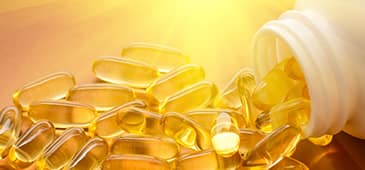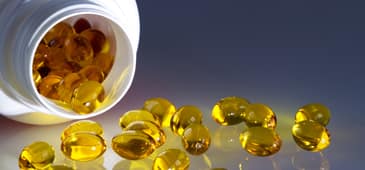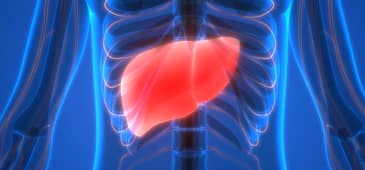
What's Hot
What's Hot
News flashes are posted here frequently to keep you up-to-date with the latest advances in health and longevity. We have an unparalleled track record of breaking stories about life extension advances.
Omega 3 could help reduce capsular contracture
 February 28 2020. The March 2020 issue of Plastic and Reconstructive Surgery®, the Journal of the American Society of Plastic Surgeons, published the finding of a protective effect for supplementation with omega 3 fatty acids against capsular contracture, a problem that affects women who have undergone breast implantation during reconstruction following breast cancer surgery or for cosmetic reasons. The capsular contracture process is characterized by hardening of the connective tissue that forms around the implant, causing inflammation, pain and occasional deformation of the implant.
February 28 2020. The March 2020 issue of Plastic and Reconstructive Surgery®, the Journal of the American Society of Plastic Surgeons, published the finding of a protective effect for supplementation with omega 3 fatty acids against capsular contracture, a problem that affects women who have undergone breast implantation during reconstruction following breast cancer surgery or for cosmetic reasons. The capsular contracture process is characterized by hardening of the connective tissue that forms around the implant, causing inflammation, pain and occasional deformation of the implant.
It is believed that silicone particles and bacterial biofilms induce chronic inflammation that causes fibroblast proliferation involved in capsular formation. "Past research on preventing capsular contracture has focused on reducing bacterial contamination using antibiotics," noted coauthor Serena Tamburino, MD. "Fewer studies have focused on controlling the inflammatory process, particularly the arachidonic acid cascade, the main pathway leading to inflammation."
In the current study, female mice were implanted with silicone gel implants and given daily omega 3 fatty acids (EPA and DHA) or water. After 12 weeks, the animals’ implants were removed and the tissue that surrounded the implants examined.
Mice that received omega 3 fatty acids had less capsule formation around implants compared to untreated animals. Treated mice exhibited a reduction in the expression of transforming growth factor beta-2 (a cytokine that promotes inflammation) associated with less collagen deposited in the implant capsule.
"We believe that omega 3 supplement is a simple and promising method that could be used to prevent or at least reduce capsular contracture after silicone implant surgery," the authors wrote. “Omega 3 fatty acid is a dietary supplement with minimal side effects that is normally used worldwide for multiple purposes.
“Additional studies should be conducted to support our findings concerning the decrease in capsular contracture occurrence,” they conclude.
—D Dye
NAC could help MS patients
 February 26 2020. The results of a trial reported on February 14, 2020 in Frontiers in Neurology indicate a potential role for N-acetylcysteine (NAC) as a treatment to improve brain function in patients with multiple sclerosis (MS). NAC is a derivative of the amino acid L-cysteine, which is a precursor of the antioxidant glutathione.
February 26 2020. The results of a trial reported on February 14, 2020 in Frontiers in Neurology indicate a potential role for N-acetylcysteine (NAC) as a treatment to improve brain function in patients with multiple sclerosis (MS). NAC is a derivative of the amino acid L-cysteine, which is a precursor of the antioxidant glutathione.
"This is an exciting study that suggests a natural molecule such as NAC may help improve brain metabolism and symptoms in patients with multiple sclerosis," corresponding author Andrew Newberg, MD, remarked.
The trial included 24 MS patients who were randomized to groups that received standard care alone or standard care plus intravenous NAC once weekly and 500 milligrams orally administered NAC twice daily for the remaining days of the week during a two-month period. Fluorodeoxyglucose (FDG) position emission tomography (PET) scanning to measure cerebral glucose metabolism was conducted and clinical and symptom questionnaires were completed by the participants at the beginning of the study and after the treatment period. Subjects who received standard care alone were eligible to receive NAC at the end of the initial treatment period.
In comparison with the control group, improvement in brain metabolism (especially in areas that support cognition) as well as self-reported improvement in cognition and focus occurred in the NAC-treated subjects.
“To our knowledge, this is the first study evaluating a possible effect of NAC in patients with MS, and specifically using FDG PET to measure cerebral glucose metabolism,” the authors announced.
"This study is an important step in understanding how NAC might work as a potentially new avenue for managing multiple sclerosis patients,” stated senior author Daniel Monti, MD, who is Chairman of the Department of Integrative Medicine and Nutritional Sciences at Thomas Jefferson University. “The NAC appears to enable neurons to recover some of their metabolic function.”
—D Dye
Olive oil key to Med diet longevity benefit
 February 24 2020. The February 20, 2020 issue of Molecular Cell published the finding of a mechanism involved in the Mediterranean diet’s effect on lifespan. Doug Mashek, PhD, and colleagues discovered that the monounsaturated fatty acids in olive oil activate a cellular pathway linked to longevity.
February 24 2020. The February 20, 2020 issue of Molecular Cell published the finding of a mechanism involved in the Mediterranean diet’s effect on lifespan. Doug Mashek, PhD, and colleagues discovered that the monounsaturated fatty acids in olive oil activate a cellular pathway linked to longevity.
"We found that the way this fat works is it first has to get stored in microscopic things called lipid droplets, which is how our cells store fat,” explained Dr Mashek, who is a professor in the Departments of Medicine and Biochemistry, Molecular Biology and Biophysics at the University of Minnesota Medical School. “And then, when the fat is broken down during exercising or fasting, for example, is when the signaling and beneficial effects are realized.”
This breakdown stimulates metabolism and mitochondria formation through a pathway that is dependent upon SIRT1/PGC-1 alpha/PPAR-alpha. SIRT1 is a gene involved in the regulation of healthspan that has been shown in mice to support health benefits associated with calorie restriction. It was discovered that monounsaturated fatty acids activate SIRT1 toward specific substances, such as PGC-1. The researchers reported that “Monounsaturated fatty acids enhance PGC-1α/PPAR-alpha signaling and promote oxidative metabolism in cells and animal models in a SIRT1-dependent manner.”
Researchers had speculated that the benefits of the Mediterranean diet were due to its inclusion of red wine that contains resveratrol, which also activates SIRT1. However, the amount of resveratrol in the quantities of wine consumed by humans is not sufficient to elicit this effect.
“While undoubtedly a plethora of components in the Mediterranean diet contribute to its positive effects on health, the data presented herein provide at least one feasible biological mechanism that may underlie these well-established benefits,” the authors write.
"We want to understand the biology, and then translate it to humans, hopefully changing the paradigm of healthcare from someone going to eight different doctors to treat his or her eight different disorders," Dr Mashek remarked. "These are all aging-related diseases, so let's treat aging."
—D Dye
Green tea plus exercise lowers fatty liver disease severity
 February 21 2020. The February 2020 issue of The Journal of Nutritional Biochemistry published the finding of Pennsylvania State University researchers of a reduction in the severity of nonalcoholic fatty liver disease in mice that exercised and were given an extract of green tea.
February 21 2020. The February 2020 issue of The Journal of Nutritional Biochemistry published the finding of Pennsylvania State University researchers of a reduction in the severity of nonalcoholic fatty liver disease in mice that exercised and were given an extract of green tea.
Mice were fed a high fat diet for 16 weeks to model human obesity. Some of the animals were given access to a running wheel while others received green tea extract with or without access to a wheel.
While mice that received either exercise or green tea extract had half the amount of liver fat than the control group of mice that received neither treatment, animals that received both treatments had an average amount of liver fat that was 80% lower. Mice that exercised and consumed green tea extract had greater excretion of fat and lower plasma levels of the liver enzyme alanine aminotransferase. They also exhibited increased expression of genes associated with mitochondrial biogenesis in comparison with the control group. "We measured the expression of genes that we know are related to energy metabolism and play an important role in energy utilization," commented senior investigator Joshua Lambert. "In the mice that had the combination treatment, we saw an increase in the expression of genes that wasn't there before they consumed green tea extract and exercised."
"By examining the livers of these mice after the study concluded and by screening their feces during the research, we saw that the mice that consumed green tea extract and exercised actually were processing nutrients differently -- their bodies were handling food differently," Dr Lambert observed. "We think the polyphenols in green tea interact with digestive enzymes secreted in the small intestine and partially inhibit the breakdown of carbohydrates, fat and protein in food."
—D Dye
Trial suggests liver benefit for vitamin E in HIV patients
 February 19 2020. The February 1, 2020 issue of AIDS published the results of a pilot trial which indicated a benefit for vitamin E among human immunodeficiency virus (HIV) patients with nonalcoholic steatohepatitis (NASH), a form of nonalcoholic fatty liver disease (NAFLD) that is associated with an increased risk of cirrhosis and cancer of the liver.
February 19 2020. The February 1, 2020 issue of AIDS published the results of a pilot trial which indicated a benefit for vitamin E among human immunodeficiency virus (HIV) patients with nonalcoholic steatohepatitis (NASH), a form of nonalcoholic fatty liver disease (NAFLD) that is associated with an increased risk of cirrhosis and cancer of the liver.
"Vitamin E has been shown to improve fatty liver in the general population," noted lead author Giada Sebastiani, who is an associate professor at the Department of Medicine at McGill University in Quebec and a scientist at the Research Institute of the McGill University Health Centre. "Here we provide evidence for its beneficial effect and safety in people living with HIV, who have a higher prevalence of fatty liver disease."
As to why these patients have an increased incidence of fatty liver disease, Dr Sebastiani explained that "It is possibly due to HIV-related inflammation, the antiretroviral drugs that they have to take lifelong, and to very frequent metabolic problems, such as diabetes and high lipids. Unfortunately, there is no approved therapy for fatty liver in people living with HIV."
The study included 27 HIV patients with NASH who received 800 international units (IU) vitamin E per day for 24 weeks. Blood samples were analyzed for several liver factors before and after the treatment period and at the end of a subsequent 24 week follow-up period. "We found that vitamin E improved both liver transaminases (the main blood tests for liver function) and liver fat measured by a noninvasive ultrasonographic test," Dr Sebastiani reported. "These improvements were even more marked than those reported in the HIV-uninfected population."
"We would be interested in conducting a larger randomized controlled trial, with a longer follow-up," she remarked.
—D Dye
Vitamin C supplementation could lower ventilation duration
 February 17 2020. Results of an analysis published on February 7, 2020 in the Journal of Intensive Care revealed an association between the administration of vitamin C to critically ill patients and a reduction in the length of time that the use of a ventilator was required.
February 17 2020. Results of an analysis published on February 7, 2020 in the Journal of Intensive Care revealed an association between the administration of vitamin C to critically ill patients and a reduction in the length of time that the use of a ventilator was required.
“Without supplementation, plasma vitamin C levels are particularly low in critically ill patients, indicating that the body may have a greater need for vitamin C when under severe stress such as illness requiring intensive care,” wrote Harri Hemilä and Elizabeth Chalker. “It seems evident that there are gradual changes in vitamin C metabolism according to the severity of disease, in that the sicker a patient is, the greater the consumption of vitamin C. This further suggests that the sicker a patient is, the more they are likely to benefit from additional vitamin C.”
The duo pooled the results of eight controlled trials that compared the length of ventilation among patients who received intravenous or orally administered vitamin C to the ventilation duration of control groups who did not receive the vitamin. Upon having determined a 14% reduction in time spent using a ventilator among subjects who received vitamin C, they subsequently limited the analysis to trials that involved longer ventilation times of ten hours or more, which suggests more severe disease. This resulted in the finding of a reduction in average ventilation time of 25% among patients who received one to six grams vitamin C per day.
"Vitamin C is a safe, low-cost essential nutrient,” Dr Hemilä remarked. “Given the strong evidence of benefit for more severely ill critical care patients along with the evidence of very low vitamin C levels in such patients, ICU patients may benefit from the administration of vitamin C. Further studies are needed to determine optimal protocols for its administration.”
—D Dye
Vitamin D deficiency among factors associated with postmenopausal disc degeneration
 February 14 2020. A retrospective study reported on February 12, 2020 in Menopause, the Journal of The North American Menopause Society, uncovered an association between deficient levels of vitamin D and disc degeneration/lower back pain in women. Disc degeneration is a significant source of lower back pain that affects more women than men and is believed to be caused, in part, by a decline in estrogen production.
February 14 2020. A retrospective study reported on February 12, 2020 in Menopause, the Journal of The North American Menopause Society, uncovered an association between deficient levels of vitamin D and disc degeneration/lower back pain in women. Disc degeneration is a significant source of lower back pain that affects more women than men and is believed to be caused, in part, by a decline in estrogen production.
The study included 232 postmenopausal women of who enrolled between July 2017 and December 2018. Hao-Wei Xu and colleagues evaluated data concerning lumbar disc degeneration, serum 25-hydroxyvitamin D levels and markers of bone turnover.
Vitamin D levels of more than 30 nanograms per milliliter (ng/mL), which were categorized as normal, were present among just 12.5% of the subjects and severely deficient levels of less than 10 ng/mL were found in 12.9%. Women who were severely deficient in vitamin D had higher scores for low back pain and lower bone mineral density scores than the remainder of the participants. Decreasing vitamin D levels were associated with increasing severity of disc degeneration. Adjusted analysis of the data associated vitamin D deficiency, failure to supplement with the vitamin, smoking, low bone mineral density and high body mass index with a greater incidence of moderate to severe pain.
"This study shows that very low vitamin D levels were linked to a greater likelihood of moderate to severe lower back pain and more severe lumbar disc degeneration, possibly because of the beneficial effects vitamin D has on nerve and muscle pain sensitivity, muscle strength and mass, and inflammation,” commented Dr Stephanie Faubion, medical director of the North American Menopause Society. “Although not all women need vitamin D supplementation, this speaks to the importance of avoiding severe vitamin D deficiency states."
—D Dye
Vitamin D deficient mothers risk having children with ADHD
 February 12 2020. A study published on December 18, 2019 in the Journal of the American Academy of Child & Adolescent Psychiatry revealed a link between low maternal levels of vitamin D during women’s pregnancies and an increased risk of attention deficit hyperactivity disorder (ADHD) in their children.
February 12 2020. A study published on December 18, 2019 in the Journal of the American Academy of Child & Adolescent Psychiatry revealed a link between low maternal levels of vitamin D during women’s pregnancies and an increased risk of attention deficit hyperactivity disorder (ADHD) in their children.
“Recent evidence has highlighted the importance of vitamin D in the development of the central nervous system,” Minna Sucksdorff, MD, of the University of Turku in Finland and colleagues write. “Some studies have shown an association between maternal vitamin D deficiency during pregnancy and offspring attention-deficit/hyperactivity disorder (ADHD) symptoms based on parent or teacher ratings. There are no previous studies on early pregnancy 25-hydroxyvitamin D levels and the risk of diagnosed offspring ADHD.”
Using archived blood samples collected from pregnant women’s first trimester, the researchers measured 25-hydroxyvitamin D levels from 1,067 women who gave birth to children with ADHD and 1,067 matched control subjects. They found a significant association between declining maternal vitamin D levels and an increased risk of having children with ADHD. Women whose vitamin D levels were among the lowest 20% of all subjects had a 53% greater risk of having a child who developed ADHD than women whose levels were among the top 20%.
The current investigation is part of a project whose goal is to identify connections between women’s health during pregnancy and the presence of ADHD in their children in order to help determine risk and aid the development of preventive therapies. Lead investigator Andre Sourander of the University of Turku and Columbia University Medical Center noted that vitamin D deficiency remains a global challenge despite recommendations from experts to improve low levels. The study’s results could have significance for public health due to the considerable prevalence of ADHD.
—D Dye
Brassica compound may help prevent NAFLD
 February 10 2020. Research reported on January 17, 2020 in Hepatology suggests a role for a compound known as indole in the prevention of nonalcoholic fatty liver disease (NAFLD), a condition in which the liver develops fatty deposits that is significantly more common among obese individuals than among those who are not obese. Indole occurs in Brussels sprouts, cabbage, cauliflower and other members of the Brassica family, and is also found in bacteria that reside in the gastrointestinal tract.
February 10 2020. Research reported on January 17, 2020 in Hepatology suggests a role for a compound known as indole in the prevention of nonalcoholic fatty liver disease (NAFLD), a condition in which the liver develops fatty deposits that is significantly more common among obese individuals than among those who are not obese. Indole occurs in Brussels sprouts, cabbage, cauliflower and other members of the Brassica family, and is also found in bacteria that reside in the gastrointestinal tract.
In a study involving 137 participants, Chaodong Wu, MD, PhD, of Texas A&M University and colleagues observed an association between a higher body mass index and lower blood levels of indole. Obese subjects had indole levels that were significantly lower than those of lean subjects and they also had a greater amount of liver fat. Animals given a high fat diet along with indole developed less liver fat and inflammation compared to those that did not receive the compound. In cultured cells, indole was shown to stimulate the expression of the gene PFKFB3 which regulates glycolysis, the first step in the breakdown of glucose for energy.
"Based on this research, we believe healthy foods with high capacity for indole production are essential for preventing NAFLD and are beneficial for improving the health of those with it," Dr Wu stated. "This is another example where altering the diet can help prevent or treat disease and improve the well-being of the individual."
"Foods with a high capacity of indole production or medicines that mimic its effects may be new therapies for treatment of NAFLD," he added. "Preventing NAFLD's development and progression may depend on nutritional approaches to ensure that gut microbes allow indole and other metabolites to function effectively. Future research is needed to investigate how certain diets may be able to achieve this."
—D Dye
Meta-analysis concludes lipid benefit for grape polyphenols
 February 05 2020. The February 2020 issue of the Journal of Clinical Medicine adds evidence to a lipid-lowering effect for grape polyphenols in men and women.
February 05 2020. The February 2020 issue of the Journal of Clinical Medicine adds evidence to a lipid-lowering effect for grape polyphenols in men and women.
For their analysis, Roberta Lupoli of Federico II University in Naples, Italy and colleagues selected 24 articles that reported the outcome of randomized, controlled trials comparing the effects of whole grape products, grape juice, grape seed extracts or grape skin to a placebo or no treatment among a total of 1,205 participants. The reports provided information concerning total cholesterol, high-density-lipoprotein (HDL) cholesterol, low-density lipoprotein cholesterol (LDL), oxidized LDL cholesterol, apolipoprotein A, apolipoprotein B and/or triglyceride levels before and after treatment.
Analysis of the data found reductions in total cholesterol, LDL, cholesterol, oxidized LDL cholesterol, apolipoprotein B and triglycerides, and an increase in HDL cholesterol in association with grape supplementation. The strongest improvements were observed in LDL cholesterol, which was lowered by an average of 5.6 milligrams per deciliter in participants who received grape supplements, and in oxidized LDL, which was reduced by an average of 5.0 units per liter. Further analysis revealed that the reduction in LDL was significant when daily grape polyphenol supplementation was greater than 400 milligrams per day.
“To the best of our knowledge, this is to date the largest meta‐analysis evaluating the relationship between grape product intake and lipid profile,” Dr Lupoli and her associates announced.
“The present meta‐analysis shows that grape polyphenols exert a favorable effect on lipid profile in humans by significantly reducing plasma levels of LDL cholesterol and oxidized LDL cholesterol,” they concluded. “The lipid‐lowering effect of grape polyphenols seems to occur in healthy subjects as well as in subjects with a range of metabolic abnormalities. Additional trials specifically in patients with dyslipidemia or diabetes mellitus are required to confirm this finding.”
—D Dye
Nobiletin stabilizes circadian clocks in diabetes
 February 03 2020. Research reported on January 21, 2020 in the Proceedings of the National Academy of Sciences provides new information concerning circadian clock disruptions associated with type 2 diabetes and the ability of nobiletin, a flavonoid that occurs in citrus peel, to re-establish circadian regulation.
February 03 2020. Research reported on January 21, 2020 in the Proceedings of the National Academy of Sciences provides new information concerning circadian clock disruptions associated with type 2 diabetes and the ability of nobiletin, a flavonoid that occurs in citrus peel, to re-establish circadian regulation.
Earlier research in rodents demonstrated that disruption of cellular clocks in the pancreas altered the secretion of the pancreatic islet hormones insulin and glucagon. "We had also previously observed that if the clocks of human pancreatic cells were artificially disrupted in the cellular culture in vitro, secretion of the key islet hormones - insulin and glucagon - was compromised,” commented first author Volodymyr Petrenko. “Hence our next step, that we report here, was to unravel whether the circadian rhythms were perturbed in human pancreatic islets in type 2 diabetes, and, if so, how would this perturbation affect the islet function."
The research team, led by Charna Dibner of the University of Geneva, compared pancreatic islet cells from human donors with and without diabetes. “Strikingly, our experiments reveal that islets from type 2 diabetes patients contain clocks with diminished circadian amplitudes and reduced in vitro synchronization capacity compared to their nondiabetic counterparts,” they reported.
"The verdict is indisputable,” Dr Dibner affirmed. “As a result, hormone secretion is no longer coordinated. Moreover, the defects in temporal coordination of insulin and glucagon secretion observed in patients with type-2 diabetes were comparable to those measured in healthy islet cells with artificially-disrupted circadian clock."
This defect was reversed by the administration of nobiletin. "By acting on one of the core-clock components, it resets efficiently the amplitude of the oscillations in the human islets," Dr Petrenko explained. "And as soon as we got the clocks back in sync, we also observed an improvement in insulin secretion."
"This is the first proof of principle that repairing compromised circadian clocks may help improving the function of the pancreatic islet hormone secretion,” Dr Dibner announced. "By resynchronizing the perturbed molecular clocks, either by personalized eating and exercise schedules or with the help of clock modulator molecules, we hope to ultimately be able to provide an innovative solution to an epidemical metabolic problem affecting an ever-increasing proportion of the world's population."
—D Dye

